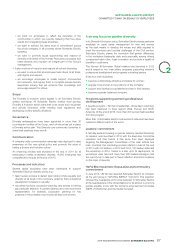APC 2015 Annual Report Download - page 85
Download and view the complete annual report
Please find page 85 of the 2015 APC annual report below. You can navigate through the pages in the report by either clicking on the pages listed below, or by using the keyword search tool below to find specific information within the annual report.
2015 REGISTRATION DOCUMENT SCHNEIDER ELECTRIC 83
SUSTAINABLE DEVELOPMENT
2
COMMITTED TO AND ON BEHALF OFEMPLOYEES
Flagship program: Marco Polo
Launched in 2001, Marco Polo is an internal recruitment and
development program to engage high potential employees in
overseas missions. This unique program allows to prepare a future
generation of leaders for Schneider Electric, while considering
present business needs and anticipating future conditions. Since the
inception of the program, the Group has provided over 850 junior
profi les from 70 different nationalities with truly diverse assignments
in 56 different countries.
University p artnerships
Schneider Electric continues to focus on key relationships with
a core selection of partner universities throughout the world.
This enables a deep relationship to develop for the benefi t of all.
R elationships have primarily been developped with universities
with specialisms that align with our business - most commonly in
engineering, energy management or technology. Ranging from:
•sharing of our business acumen – for example competitions and
guest lectureships;
•sponsorship initiatives;
•on campus recruitment events.
This approach has enabled strong talent pipelines to be established
for key target skills and greater awareness of Schneider Electric as
an employer.
Our e mployer b rand and s ocial m edia
Over the last two years, a coordinated and integrated approach
has been taken, with regards to maximizing usage of key social
media channels, to further build the Schneider Electric presence
and expand its reach. Highlights include:
•improved organization and branding of major social media
channels;
•through internal engagement, increased advocacy of Schneider
Electric as an employer has been achieved; by our people,
through social media, for recruitment purposes;
•launch of a dedicated «Schneider Electric Careers» Facebook
page; to engage in conversation with potential candidates and
provide authentic content about Schneider Electric as a place
to work.
Further recognition
External validation of our ongoing employer branding strategy is
crucial in validating Schneider Electric as a potential «employer of
choice ». In 2015, recognition was received by achieving for the
4th year running, a ranking in the top 50 (44th place) globally in
Universum’s «World’s Most Attractive Employers» results among
engineering students; the rankings are based on the nominations
of almost 240,000 business and engineering students from top
universities in the world’s 12largest economies.
4.4 Fostering talent and skills
The ongoing growth of Schneider Electric’s businesses in markets
around the world requires the development of leaders and
innovators across all disciplines. Matrix organization structures and
virtual teams place new demands on employees. The Schneider is
On company program initiatives, such as digitization, simplifi cation,
growing services business or customized supply chain,etc., also
require ongoing adaptation and skills enhancement. Learning and
career development is therefore at the heart of Schneider Electric’s
Human Resources policy.
Approach
There is a strong focus on Learning in our Schneider is On 2015-
2017 company program. Within this program, «Step-up» defi nes
strong ambitions in training, fosters a culture where employees
take the initiative to learn, grow their skills and drive their career
development. Employees should feel able to do so regardless of
their origin (education, background, nationalities, gender, business,
level,etc.).
The following indicators have been defi ned to track progress in this
direction: the percentage of employees who receive a minimum of one
day’s training each year; and the number of employees who express
their satisfaction via the OneVoice survey on the fact that they «have
appropriate opportunities for personal and professional growth».
In 2015, the Group redefi ned its training strategy around three
components:
•a culture of inclusive training by pursuing its goal of one day
training per year and per employee;
•the development of the best experts by function; this includes the
defi nition of a training pathway for the positions deemed critical
and also a strengthening of the «on boarding» process based on
the principle of a «driver’s license», which consists in a series of
training and interviews to be performed in the fi rst three months
after arriving in the company;
•digital in the service of training; a willingness to offer more digital
content that is richer and more social (in the social network
meaning of the term), and take advantage of the My Learning
Link platform to measure the activity as well as the impact of the
training programs on employee productivity and commitment.
Schneider Electric places a strong focus on the effective
management of talent at all levels. To this end, a talent review
process operates across the organization to help ensure that
talented individuals are identifi ed and realize their full career
potential. Structured succession planning for critical roles helps
to accelerate individual career development while maintaining
continuity for the organization. In selecting and developing talent,
an important consideration is also to foster diversity such as gender
and nationalities (new economies as well as mature economies). At
the individual level, tools and processes ensure that clear goals are
set and tracked in the areas of both performance and development.
Managers and employees are able to draw on extensive resources
in support of individual development, and these activities are
formalized in an Individual Development Plan.
Talent management and performance management processes
were brought together during 2014 via the deployment of a new
integrated HR information system called TalentLink. This system
allows signifi cantly improved data management and analytics in the
























